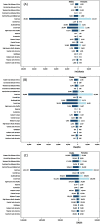Global and regional incidence, mortality and disability-adjusted life-years for Epstein-Barr virus-attributable malignancies, 1990-2017
- PMID: 32868361
- PMCID: PMC7462312
- DOI: 10.1136/bmjopen-2020-037505
Global and regional incidence, mortality and disability-adjusted life-years for Epstein-Barr virus-attributable malignancies, 1990-2017
Abstract
Objective: To determine the global and regional burden of Epstein-Barr virus (EBV)-attributed malignancies.
Design: An international comparative study based on the Global Burden of Disease (GBD) Study estimates.
Setting: Global population by age, sex, region, demographic index and time.
Methods and outcome measures: The burden of EBV-attributed Burkitt lymphoma (BL), Hodgkin lymphoma (HL), nasopharyngeal carcinoma (NPC) and gastric carcinoma (GC) was estimated in a two-step process. In the first step, the fraction of each malignancy attributable to EBV was estimated based on published studies; this was then applied to the GBD estimates to determine the global and regional incidence, mortality and disability-adjusted life-years (DALYs) for each malignancy by age, sex, geographical region and social demographic index (SDI) from 1990 to 2017.
Results: The combined global incidence of BL, HL, NPC and GC in 2017 was 1.442 million cases, with over 973 000 deaths. An estimated 265 000 (18%) incident cases and 164 000 (17%) deaths were due to the EBV-attributed fraction. This is an increase of 36% in incidence and 19% in mortality from 1990. In 2017, EBV-attributed malignancies caused 4.604 million DALYs, of which 82% was due to NPC and GC alone. The incidence of both of these malignancies was higher in high and middle-high SDI regions and peaked in adults aged between 50 and 70 years. All four malignancies were more common in males and the highest burden was observed in East Asia.
Conclusions: This study provides comprehensive estimates of the burden of EBV-attributed BL, HL, NPC and GC. The overall burden of EBV-related malignancies is likely to be higher since EBV is aetiologically linked to several other malignancies not included in this analysis. Increasing global population and life expectancy is expected to further raise this burden in the future. The urgency for developing an effective vaccine to prevent these malignancies cannot be overstated.
Keywords: epidemiology; microbiology; oncology; public health.
© Author(s) (or their employer(s)) 2020. Re-use permitted under CC BY-NC. No commercial re-use. See rights and permissions. Published by BMJ.
Conflict of interest statement
Competing interests: None declared.
Figures



References
-
- Global Burden of Disease Cancer Collaboration, Fitzmaurice C, Abate D, et al. . Global, regional, and National cancer incidence, mortality, years of life lost, years lived with disability, and disability-adjusted life-years for 29 cancer groups, 1990 to 2017: a systematic analysis for the global burden of disease study. JAMA Oncol 2019;4:1749–68. 10.1001/jamaoncol.2019.2996 - DOI - PMC - PubMed
MeSH terms
LinkOut - more resources
Full Text Sources
Medical
Miscellaneous
